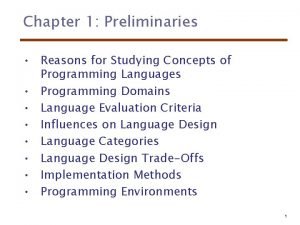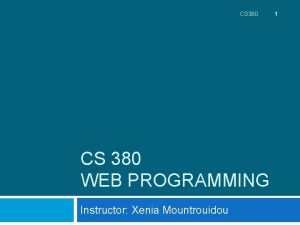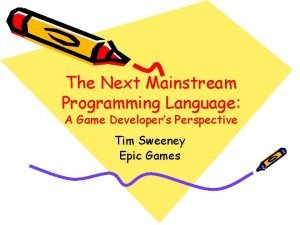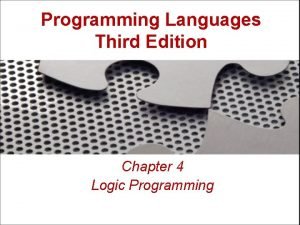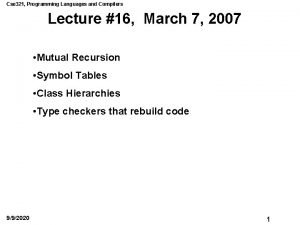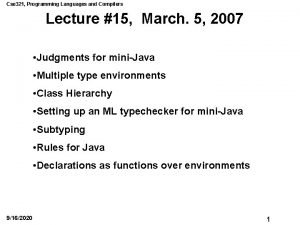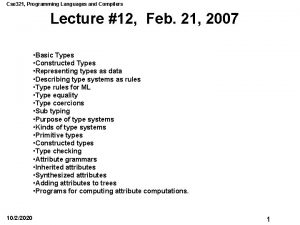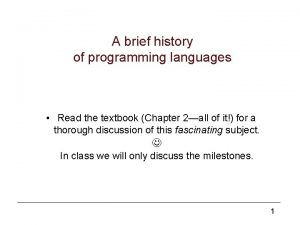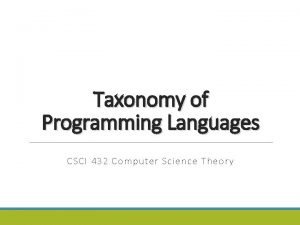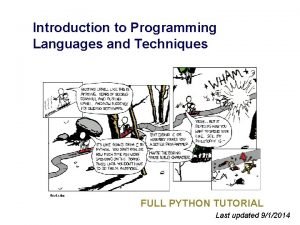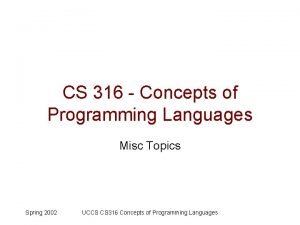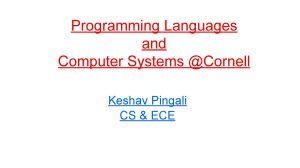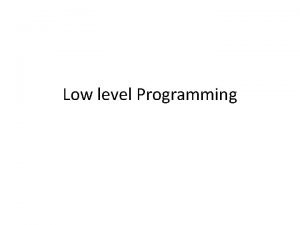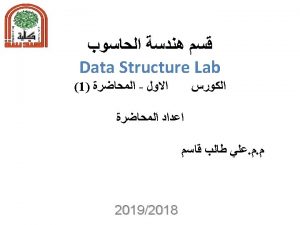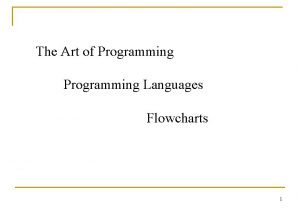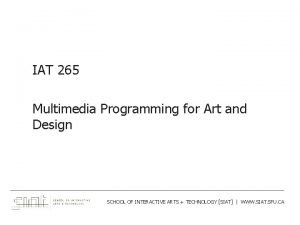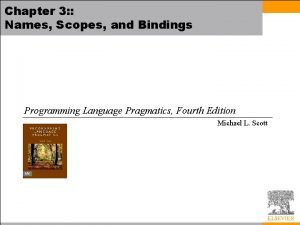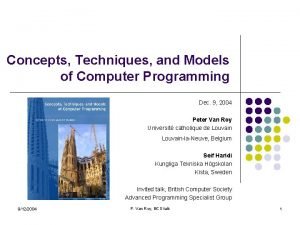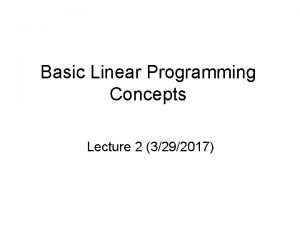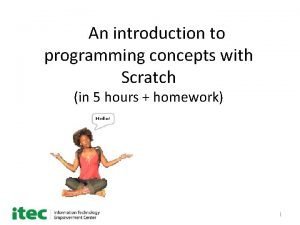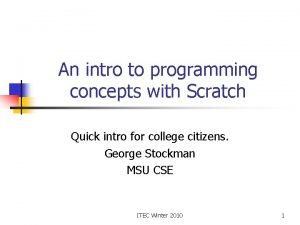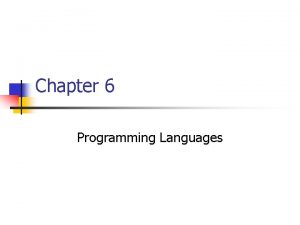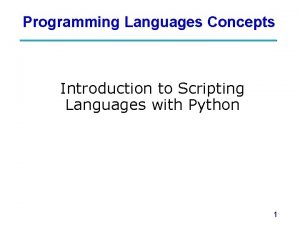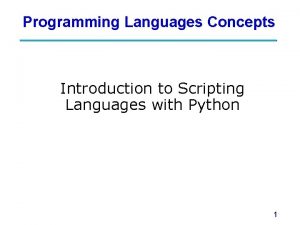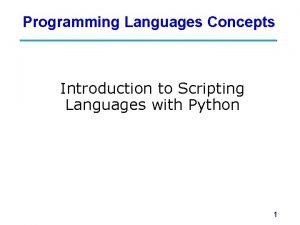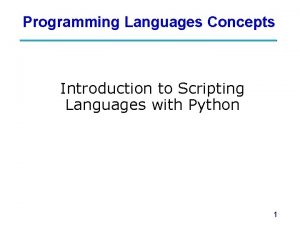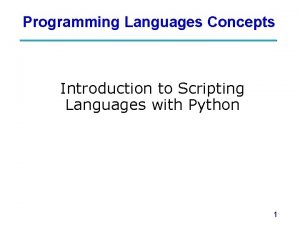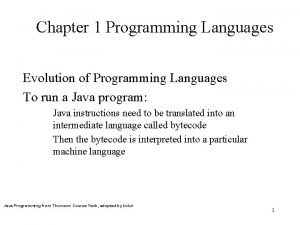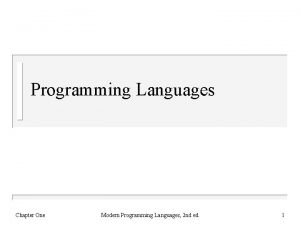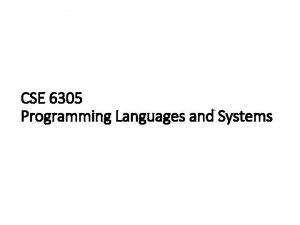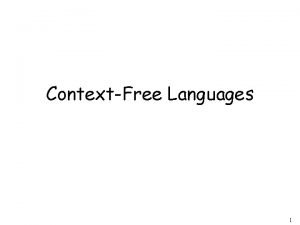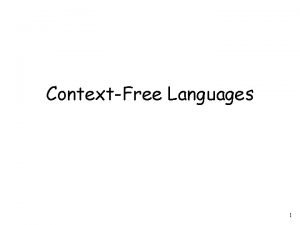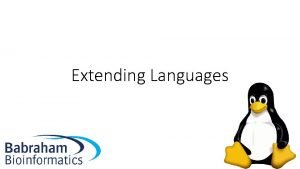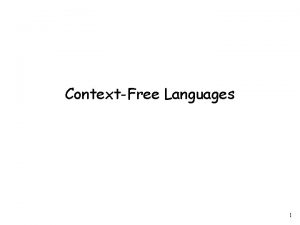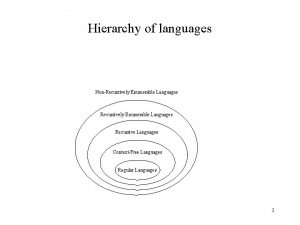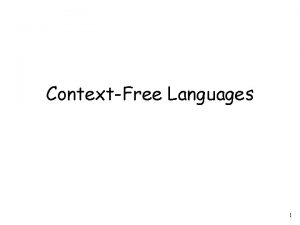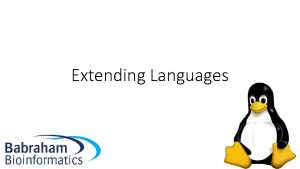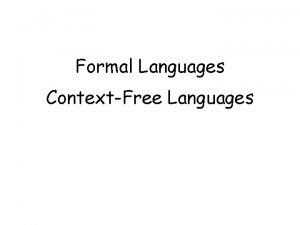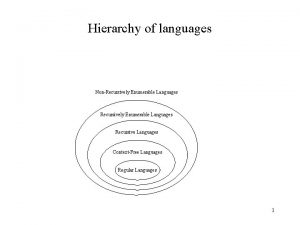Chapter 11 Programming Concepts And Languages Programming A






































- Slides: 38

Chapter 11 Programming Concepts And Languages

Programming A program is a set of instructions (codes) telling a computer how to perform various tasks. Programming is the act of creating these programs.

Coding for an HTML Document Coding is a term used by programmers to refer to the act of writing source code.

Program Language Characteristics Programming languages contain smaller vocabularies than human (natural) languages. Programming language syntax (the rules for stringing together language elements) is also less complex than human language syntax.

Classifications of Computer Languages Computer languages are classified as low level or high level. Low-level languages are called machine code— the binary language computers use. High-level languages are relatively similar to natural languages such as English.

Computer Languages Low-level languages run faster and take up less disk space. High-level languages are easier to learn and use. <meta http-equiv="Content-Type" content="text/html; charset=iso-8859 -1"> <meta name="description" content="EMC/Paradigm Publishing, publishers of textbooks and new media, is a premier book and media supplier. Offering textbooks from K 12 to the college level, including international publications. ">HTML is a high-level language.

Programming Language Generations 1 G: Machine code 2 G: Assembly language 3 G: Visual Basic, C++, etc. 4 G: Script languages such as HTML 5 G: Graphical user interface languages

The Four Main Computer Language Programming Elements Variables Looping Decision Statements Executable Statements

Large Programming Projects Many programming projects are too big to be completed by a single individual, so they require a programming team

Software Engineers Software engineers typically coordinate programming projects working with programming teams.

Problem-Solving Techniques Divide-and. Conquer Approach Problem-Solving Steps

Divide-and-Conquer Approach (Top-Down Design) 1 Break down big problems into smaller problems 2 Document process using an outline format

Problem-Solving Steps Programmers follow a standard set of 6 steps: 1. Identify the problem. 2. Analyze the problem. 3. Brainstorm solutions and choose the best one. 4. Write the algorithm. 5. Prototype the solution. 6. Implement and test the solution.

Identify the Problem Programmers must first hammer out the definition of the problem before they can begin to solve it. A programmer starts every project like an interrogator, beginning with a thorough set of questions covering every aspect that is not clear.

Analyze the Problem Analyzing the problem can involve learning new skills or concepts. If a solution requires writing a program in a particular programming language, then part of understanding the problem includes understanding the programming language.

Brainstorm Solutions The best strategy is to create a list of all possible solutions, evaluate them, and then choose the best one before proceeding.

Write the Algorithm Programs are first written out as an algorithm before being written in a programming language. An algorithm is a complete list of steps for solving a problem. Algorithms usually are written in pseudocode, which is a very high-level language that computers cannot read.

Write the Algorithm A pseudocode algorithm for changing a lightbulb • • • Get stepladder from closet. Place stepladder under fixture. Turn switch off. Remove fixture from ceiling. Remove old lightbulb from socket. Put old lightbulb into trash can. Get new lightbulb from cupboard. Put new lightbulb into socket. Place fixture on ceiling. Turn switch on. Put stepladder into closet.

Prototype the Solution Prototyping means creating a small semi-functional version of the solution to see if and how it works. Prototyping gives a better idea of whether or not the solution is going to work before weeks or months of effort are put into it. Second, it gives real form to the solution, allowing the creator to show the solution to others and get their feedback.

Implement and Test the Solution Solve the problem. This is where the program is actually coded. Testing the solution frequently as each step of the algorithm is translated into a program helps ensure fast and accurate development. During the implementation phase, programmers install the planned solution. Documentation, such as a user’s manual, is often written at this stage of the project.

The Evolution of Programming Approaches Structured Programming Modularity Object-Oriented Programming (OOP) Rapid Application Development (RAD)

Structured Programming Structured programming presented guidelines for an organized, logical approach that focuses on thinking at a higher level. The programmer thinks in terms of structured groups of instructions. A section of code is often called a routine or function. Code for that function is then broken down into steps. The process of creating groups of instructions as independent elements is the essence of structured programming.

Modularity Programmers work to create code modules that handle the separate components of a program: • Makes the code reusable • Helps in tracking down the source of errors. • Saves time because programmers don’t have to “reinvent the wheel” every time they write new programs. The more independent and reliable the elements of a program are, the higher the modularity of a program is said to be.

Object-Oriented Programming (OOP) Object-oriented programming (OOP) defines each module (called an object) with definite rules for interfacing and a protected set of variables. Protected variables are one of the key advancements in programming, as they allow a programmer to prevent data from being altered during program execution. A programmer working with a team sets up rules for the legal use of an object’s data, thereby reducing the chances for error when someone unfamiliar with the code tries to use it.

Rapid Application Development (RAD) The primary focus of RAD was designing methods to reduce costs by decreasing the time it takes to develop a project. Changes included eliminating labor-intensive written phases of the design stage by moving to early prototyping and by using higher-level languages. Visual Basic, Delphi, and other high-level languages with good interface capabilities are often used in RAD.

Rapid Application Development (RAD) Programmers using RAD follow these guidelines: Use visual development (4 GL) tools whenever possible. Rapidly prototype new projects in order to reduce redesign time. Approach coding with these priorities: 1 Use existing code first. 2 Buy existing code second 3 Write new code last

Development Tools Compilers: • Programs that translate source code into machine language • A compiler reads entire program and displays list of errors that might be present. Interpreters: Programs that translate instructions one-by-one as source code is written Debuggers: Software that locates program bugs and helps programmers examine operations while program is running

Programming Errors The main types of errors programmers must isolate and fix, one by one, to get a program working are: Syntax Errors: Mistakes in the way program elements are strung together; often due to typing mistakes or misunderstanding the rules of the language Logic Errors: Incorrect instructions to computer; thus action performed incorrectly Run-time Errors: Code mistakes that cause program to stop running; examples: crash bugs, infinite loops Style Errors: Ways in which program was written; program may still run

Hacking Code Lbgkigmfadmbvfp Bgfobnkbnvonkngf, . bg Gnn. ghlnhl. grfggn 1 nh 21 BVV<blmgf. rg Pglbnn] Gdb; bvl[pn. g Fj. Th[lnl; m, mlp, nbl Hacking code means writing code without carefully planning and structuring the program.

Documentation Tools Flowcharts: Visual diagram of an algorithm CASE Tools: Suite of applications that help programming team schedule and coordinate its operations Comments: Explanations inserted into program source code

Commercial Software Life Cycle

Major Programming Languages The very first programming language was machine code.

Assembly Language Assembly language was invented to make programming easier by attaching symbols and words to represent the numbers in machine code. Assembly languages run the fastest and use the least memory.

Older Programming Languages COBOL: Developed in 1960 by Dr. Grace Hopper and used chiefly for large business applications FORTRAN: Created in 1957, FORTRAN was language of choice for math, science, and engineering projects. Both programs are still used by large organizations such as the IRS, the Social Security Administration, the federal banking system, the military, and universities.

Older Programming Languages RPG: BASIC: Commonly used in business environments, particularly in programs for IBM AS/400 mainframe Created in 1960 s as a teaching tool, BASIC only supports command-line interfaces; an interpreted language

High-Level Programming Languages C Java C# C++ Script Languages Visual Basic

High-Level Programming Languages C: Developed at Bell Labs in early 1970 s; combines aspects of BASIC and Assembly language C++: Superset of C with added features such as objectoriented programming C#: Object-oriented language derived from C++ and Java: Composed of applets that can run on all types of platforms, Java was created to facilitate communication on the Internet Scripting Languages: Interpreted languages; nonprocedural, meaning they explain what the computer should do in Englishlike terms but not precisely how to do it; examples: VBScript, Perl, Java. Script; DHTML, XHTML

On the Horizon DEVELOPMENT SERVICE PROVIDERS (DSPS) Development service providers (DSPs) are a new class of online software development packages that allow software developers in geographically separate locations to work together on the same software. ECLIPSE: AN OPEN-SOURCE DEVELOPMENT TOOLKIT Announced in November 2001 by IBM, Eclipse project has the goal of developing a universal development tool platform into which various vendors can integrate best-of-breed software development tools. This is a significant step toward establishing an open-source development toolkit. SOFTWARE WRITING SOFTWARE The development of robotics systems for building smaller computer components is the driving force behind the miniaturization of computers.
 Reasons for studying concepts of programming languages
Reasons for studying concepts of programming languages Real-time systems and programming languages
Real-time systems and programming languages Cs 421 programming languages and compilers
Cs 421 programming languages and compilers Advantages of application software
Advantages of application software Real time programming language
Real time programming language Cs 421 uiuc
Cs 421 uiuc Real time example of multithreading in java
Real time example of multithreading in java Cxc it
Cxc it Introduction to programming languages
Introduction to programming languages Plc coding language
Plc coding language Joey paquet
Joey paquet Comparative programming languages
Comparative programming languages Alternative programming languages
Alternative programming languages Strongly typed vs weakly typed
Strongly typed vs weakly typed Transmission programming languages
Transmission programming languages Adam doupe cse 340
Adam doupe cse 340 Types of programming languages
Types of programming languages Xenia programming languages
Xenia programming languages Mainstream programming languages
Mainstream programming languages Cse 340 principles of programming languages
Cse 340 principles of programming languages Programming languages
Programming languages Programming languages
Programming languages Programming languages
Programming languages Programming languages
Programming languages Attribute grammar in principles of programming languages
Attribute grammar in principles of programming languages Brief history of programming languages
Brief history of programming languages Lisp_q
Lisp_q Xkcd programming language
Xkcd programming language If programming languages were cars
If programming languages were cars Cornell programming languages
Cornell programming languages Low level programming language
Low level programming language Middle level programming languages
Middle level programming languages The art of programming language
The art of programming language Multimedia programming languages
Multimedia programming languages Storage management in programming languages
Storage management in programming languages Concepts, techniques and models of computer programming
Concepts, techniques and models of computer programming Linear programming basic concepts
Linear programming basic concepts Scratch programming concepts
Scratch programming concepts Scratch programming concepts
Scratch programming concepts
